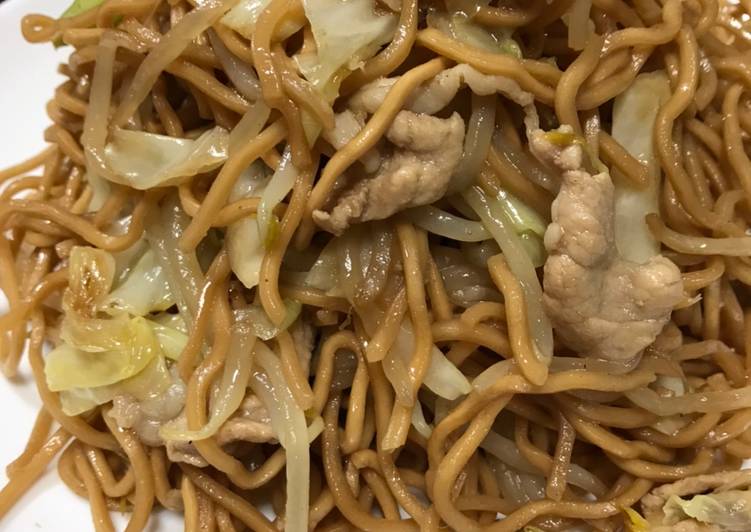
Hey everyone, it is me, Dave, welcome to my recipe site. Today, I will show you a way to prepare a special dish, yakisoba (japanese stir fry noodles). One of my favorites. This time, I will make it a little bit tasty. This will be really delicious.
Yakisoba (Japanese stir fry noodles) is one of the most favored of recent trending meals in the world. It is simple, it’s quick, it tastes yummy. It is appreciated by millions daily. They’re fine and they look wonderful. Yakisoba (Japanese stir fry noodles) is something which I have loved my whole life.
Yakisoba (焼きそば) is the Japanese version of stir-fried noodles. The noodles are cooked with sliced pork and plenty of vegetables, then coated with a special sauce. What distinguishes Yakisoba from other Asian stir-fried noodles is this special sauce, which is sweet and a little bit spicy.
To get started with this recipe, we have to first prepare a few ingredients. You can cook yakisoba (japanese stir fry noodles) using 17 ingredients and 9 steps. Here is how you cook it.
The ingredients needed to make Yakisoba (Japanese stir fry noodles):
- Make ready 1 Onion
- Prepare 1 Carrot
- Get 6 Mushrooms
- Get 2 Spring onions
- Take Half bag Been sprouts optional
- Make ready 6 Cabbage leaves
- Make ready 350 g Sliced beef (Your chice of meats or seafood)
- Prepare 3 bags egg noodles
- Get 6 Tbs Yakisoba sauce(recipe below)
- Make ready 4 Tbs Worcestershire sauce
- Get 4 Tsp Oyster sauce
- Take 4 Tsp Ketchup
- Make ready 2 Tsp Soy sauce
- Get 2 Tsp Sugar(add more sugar, if needed.)
- Make ready Toppings (Optional)
- Get 2 Tsp Aonori (dried green seaweed)
- Get 3 Tsp Pickled red ginger
Both dishes feature stir fried noodles, however, Chinese chow mein uses wheat noodles that are often fried. Yakisoba is a classic Japanese stir fry noodles recipe. You can make it simple with cabbage, onions and scallions or add your faviorite veggies and protein. For these Japanese stir fry noodles you can use pretty much anything you want.
Instructions to make Yakisoba (Japanese stir fry noodles):
- To make Yakisoba sauce.Whisk all ingredients for yakisoba sauce.and set aside.
- To make Yakisoba.Slice the onion, cut the carrot into julienned strips, and slice the mushrooms.
- Chop the spring onion into 2 inch pieces, cut the cabbage into small bite pieces and cut the meat into 1 inch pieces.
- In a skillet or wok, heat oil on medium high heat. Cook the meat until no longer pink.
- Add the onion and carrot and cook for 1-2 minutes.
- Add the cabbage and been sprouts cook until almost tender.
- Lastly add the spring onion and mushrooms and cook for 1 minute. Season with freshly ground black pepper.
- Transfer the yakisoba noodles to a sieve and quickly run hot water over yakisoba noodle. Separate the noodles with hands. Add the noodles to the skillet/wok, and lower the heat to medium. It’s best to use tongs to combine the noodles with ingredients. Keep an eye on the noodles as they may stick to the skillet/wok.
- Add Yakisoba Sauce. Depending on the amount of ingredients, adjust the amount of sauce to use. Mix all together using tongs. Transfer to plates and garnish with dried green seaweed and pickled red ginger. Serve immediately.
You can leave out the meat for a vegetable yakisoba. Yakisoba is usually made with long, thin ramen noodles stir fried with sliced onion, carrot, cabbage, bean sprouts, and a slathering of yakisoba sauce. It's a popular street food snack in Japan. You'll often come across it sizzling away on piping hot teppans (Japanese hot plates) at street festivals or. Yakisoba is Japanese stir fried noodles.
So that’s going to wrap this up with this exceptional food yakisoba (japanese stir fry noodles) recipe. Thank you very much for your time. I’m sure you can make this at home. There is gonna be interesting food in home recipes coming up. Don’t forget to save this page on your browser, and share it to your family, friends and colleague. Thanks again for reading. Go on get cooking!


